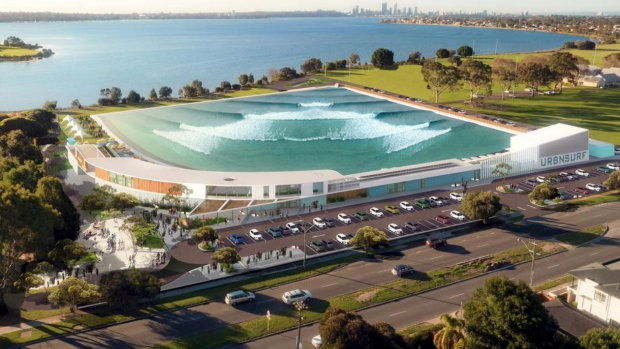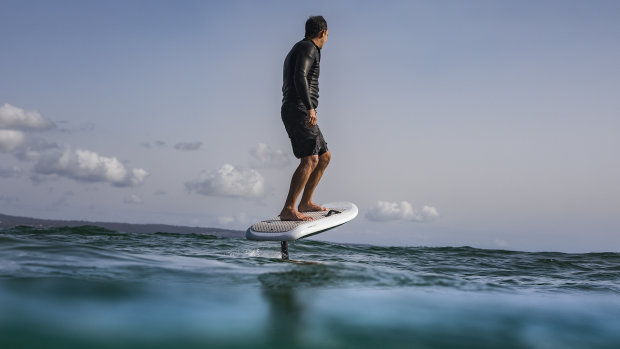A vision of Ross’ since 2012, when he met the creators of Spanish wave park tech company Wavegarden, the venture has taken the better part of seven years to come to life.
While in testing mode in the last months, Ross has personally ridden more than 800 waves and 70 barrels, while sharing rides with the likes of Chris Hemsworth and surfing elites Taj Burrow and Tyler Wright.
The former lawyer and investment banker says he wants to create a space that would appeal to professional surfers and beginners alike.
“The challenge was how to create a church to surfing and an environment that would be inviting for a range of different surfers. A measure of success for us will be a bunch of Victorian surfers feeling like we’re their local,” Ross says.

“But we’ve also had the Australian Olympic surfing team here and some elite juniors and they get to do things they rarely get to do in the ocean because they previously haven’t been able to practice over and over again.”
Ross started the business after taking a year off from his corporate jobs when he turned 40 and found a way to unite his profession with his passion.
The wave park takes up 5.4 hectares owned by Melbourne Airport, with the pool taking up 2 hectares – around the size of the Melbourne Cricket Ground oval. It is divided into four sections, catering for beginners to elite surfers and it will have a maximum capacity of 84 surfers per hour.
The site will be powered completely by renewable energy sources and is, according to Ross, the largest recycled concrete structure in the country, made up of concrete from demolished airport runways.
To fund the site, Ross spent a large part of 2017 hitting up investors with the help of corporate adviser David Williams of Kidder Williams. While he would not reveal how much he had raised, it is believed to be upwards of $28 million.
Early investors in the company included Merchant Group’s Andrew Chapman and Veris managing director Adam Lamond.
Chapman was introduced to Ross through his travel agent and has invested $2 million in the wave park.
“Given the broad appeal – from little kids learning, to guys that can seriously surf – I think it’s a great concept that will be embraced by the public everywhere regardless of how close you live to the beach,” he said.
Williams, who intends to be a regular at the wave park, says at first investors didn’t understand why surfers would pay for something they could do for free in the ocean, but he got the raise away, and it was supported by wealthy investors and a hedge fund.
“At the time… there were only two other commercial wave parks operating using technology from [Wavegarden]. However, these had only just opened and had a limited track record with which to convince investors that Urbnsurf would be a success,” he said.
Fliteboard
Tackling the other aspect of surfing, the board, Fliteboard is Trewern’s fifth business and his electric flying surfboard (eFoil) has already caught the attention of some of the world’s wealthiest water sports fans.
Counting brothers and SEEK co-founders Andrew and Paul Bassat as investors, alongside Hong Kong’s Lei Zhang of Hillhouse Capital, the company has sold 650 boards to date after beginning to ship them about six months ago.
Described by Shopify founder Tobias Lutke as “the most magical gadget on the planet”, the boards, which sell for $15,950 in Australia, have already been purchased by former Formula One world champion Nico Rosberg, Sydney to Hobart winning skipper Mark Richards, Atlassian co-founder Mike Cannon-Brookes and Social Network Path founder Dave Morin.
With a love of surfing while growing up, the idea for the business came to Trewern during a sabbatical in Byron Bay, having previously spent two decades founding and running digital agency DT (now AKQA) and Republica Education.

“I thought it was going to be a niche of a niche. Hydrafoil surfing with a kite is really, really hard. I initially thought not many people would want to do this, be able to do it and it was going to be expensive,” Trewern says.
“You have to use your core and lower body to control the foil and upper body to control the kite, when you get it all worked out it’s an amazing thing … but what I didn’t realise was how easy this would be for people and how much it would capture people’s imagination.”
The motorised boards mean users can ride them even when there are no waves and its larger hydrofoil wings, designed by the America’s Cup foil designers, mean they’re easier to operate and less sensitive to small movement changes than the similar kite surfing products.
The first prototype was made by Trewern on a 3D printer purchased from Byron Bay’s Aldi supermarket, but the boards are now manufactured using parts from China, Thailand, Australia, Germany and the US.
It is a passion project and he wanted to be uncompromising in his vision like Steve Jobs or Elon Musk, Trewern says. That means that even with the board’s high price tag, it’s still a low-margin product at this stage.
“It’s my fifth business and it’s been more challenging than all the others because it’s a huge undertaking. I was creating a vehicle that had hundreds of parts and had to be custom designed and tested,” he says. “But if entrepreneurs weren’t optimistic, they wouldn’t do anything.”


You must be logged in to post a comment.